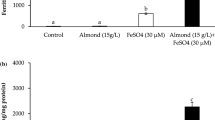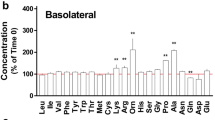Abstract
The Caco-2 cell line was used as a model to determine if the type of fatty acid, unsaturated versus saturated, differentially altered the uptake and transport of iron in the human intestine and if the changes were the result of alterations in monolayer integrity and paracellular transport. Cells were cultured in either a lower-iron or normal-iron medium and incubated with a bovine serum albumin control, linoleate, oleate, palmatate, or stearate. Oleate, palmatate, and stearate enhanced (p<0.05) iron uptake in cells grown in lower iron. The fatty acid effect on iron uptake by cells grown in normal iron was not as pronounced. Iron transport was not affected (p>0.05) by an interaction between the type of medium (iron concentration) and the type of fatty acid. Iron transport was enhanced (p<0.05) with palmatate and stearate. Various indicators of monolayer integrity and paracellular transport were also affected by the fatty acids, thus impacting iron uptake and transport. These results indicate that oleate, palmatate, and stearic can enhance iron uptake and transport; however, this enhancement may be the result of alterations in the integrity of the intestine.
Similar content being viewed by others
References
J. D. Cook and E. R. Monsen, Food iron absorption in human subjects. III. Comparison of the effect of animal proteins on nonheme iron absorption, Am. J. Clin. Nutr. 29, 859–867 (1976).
L. Hallberg and L. Rossander, Improvement of iron nutrition in developing countries—comparison of adding meat, soy protein, ascorbic-acid, citric-acid, and ferrous sulfate on iron-absorption from a Simple Latin-American-type of meal, Am. J. Clin. Nutr. 39, 577–583 (1984).
D. T. Gordon and J. S. Godber, The enhancement of nonheme iron bioavailability by beef protein in the rat, J. Nutr. 119, 446–452 (1989).
M. D. M. Engelmann, L. Davidsson, B. Sandstrom, T. Walczyk, R. F. Hurrell, and K. F. Michaelsen, The influence of meat on nonheme iron absorption in infants, Pediatr. Res. 43, 768–773 (1998).
C. E. Carpenter and A. W. Mahoney, Contributions of heme and nonheme iron to human nutrition, Crit. Rev. Food Sci. Nutr. 31, 333–367 (1992).
Phyllis E. Johnson, H. C. Lukaski, and T. D. Bowman, Effects of level and saturation of fat and iron level and type in the diet on iron absorption and utilization by the rat, J. Nutr. 117, 501–507 (1987).
R. J. Simpson, R. Moore, and T. J. Peters, Significance of non-esterified fatty acids in iron uptake by intestinal brush-border membrane vesicles, Biochim. Biophys. Acta 941, 39–47 (1988).
M. Qian and J. W. Eaton, Iron translocation by free fatty acids, Am. J. Pathol. 139, 1425–1434 (1991).
B. Mulvihill, F. M. Kirwan, P. A. Morrissey, and A. Flynn, Effect of myofibrillar muscle proteins on the in vitro bioavailability of non-haem iron, Int. J. Food Sci. Nutr. 49, 187–192 (1998).
J. H. Swain, L. B. Tabatabai, and M. B. Reddy, Histidine content of low-molecular-weight beef proteins influences nonheme iron bioavailability in Caco-2 cells, J. Nutr. 132, 245–251 (2002).
B. Mulvihill and P. A. Morrissey, Influence of the sulphydryl content of animal proteins on in vitro bioavailability of non-haem iron, Food Chem. 61, 1–7 (1998).
M Kapsokefalou and D. Miller, Lean beef and beef fat interact to enhance nonheme iron absorption in rats, J. Nutr. 123, 1429–1434 (1993).
H. C. Lukaski, W. W. Bolonchuk, L. M. Klevay, D. B. Milne, and H. H. Sandstead, Interactions among dietary fat, mineral status, and performance of endurance athletes: a case study, Int. J. Sport Nutr. Exercise Metab. 11, 186–198 (2001).
M. L. Pabón and B. Lönnerdal, Effects of type of fat in the diet on iron bioavailability assessed in suckling and weanling rats, J. Trace Elements Med. Biol. 15, 18–23 (2001).
E. A. Droke and H. C. Lukaski, Dietary iron and fat affect nonheme iron absorption, iron status, and enterocyte aconitase activity and iron concentration in rats, Nutr. Res. 16, 977–989 (1996).
P. E. Johnson, H. C. Lukaski, and E. D. Korynta, Effect of stearic-acid and beef tallow on iron utilization by the rat, Proc. Soc. Exp. Biol. Med. 200, 480–486 (1992).
H. C. Lukaski, G. D. McLaren, P. E. Johnson, and M. H. Smith, Enhanced intestinal iron-absorption by dietary stearic-acid—effect on mucosal iron kinetics, FASEB J. 7, A273-A273 (1993).
R. J. Simpson and T. J. Peters, Iron-binding lipids of rabbit duodenal brush-border membrane, Biochim. Biophys. Acta 898, 181–186 (1987).
C. Halleux and Y. J. Schneider, Iron absorption by Caco-2 cells cultivated in serum-free medium as in vitro model of the human intestinal epithelial barrier, J. Cell Physiol. 158, 17–28 (1994).
A. Dahlquist, Assay of intestinal dissacharidases, Anal. Biochem. 22, 99–107 (1968).
R. L. Sims, L. Mullen, and D. B. Milne, Application of inductively coupled plasma emission spectroscopy to multielement analysis of foodstuffs used in metabolic studies, J. Food Compos. Anal. 3, 37–37 (1990).
P. J. Trotter and J. Storch, Fatty acid uptake and metabolism in a human intestinal cell line (Caco-2): comparison of apical and basolateral incubation, J. Lipid Res. 32, 293–304 (1991).
O. Han, M. L. Failla, A. D. Hill, E. R. Morris, and J. C. Smith, Inositol phosphates inhibit uptake and transport of iron and zinc by a human intestinal cell line, J. Nutr. 124, 580–587 (1994).
G. Da Violante, N. Zerrouk, I. Richard, G. Provot, J. C. Chaumeil, and P. Arnaud, Evaluation of the cytotoxicity effect of dimethyl sulfoxide (DMSO) on Caco(2)/TC7 colon tumor cell cultures, Biol. Pharm. Bull. 25, 1600–1603 (2002).
N. R. Zerounian and M. C. Linder, Effects of copper and ceruloplasmin on iron transport in the Caco 2 cell intestinal model, J. Nutr. Biochem. 13, 138–148 (2002).
M. Boisset, R. P. Botham, K. D. Haegele, B. Lenfant, and J. I. Pachot, Absorption of angiotensin II antagonists in Ussing chambers, Caco-2, perfused jejunum loop and in vivo: importance of drug ionisation in the in vitro prediction of in vivo absorption, Eur. J. Pharm. Sci. 10, 215–224 (2000).
P. E. Johnson, H. C. Lukaski, and E. D. Korynta, Effects of stearic-acid and beef tallow on iron utilization by the rat, Proc. Soc. Exp. Biol. Med. 200, 480–486 (1992).
M. Pinto, S. Robineleon, M. D. Appay, et al., Enterocyte-like differentiation and polarization of the human-colon carcinoma cell-line Caco-2 in culture, Biol. Cell 47, 323–330 (1983).
M. Rousset, The human colon carcinoma cell lines HT-29 and Caco-2: two in vitro models for the study of intestinal differentiation, Biochimie 68, 1035–1040 (1986).
K. J. H. Wienk, J. J. M. Marx, and A. C. Beynen, The concept of iron bioavailability and its assessment, Eur. J. Nutr. 38, 51–75 (1999).
D. X. Sun, H. Lennernas, L. S. Welage, et al., Comparison of human duodenum and Caco-2 gene expression profiles for 12,000 gene sequences tags and correlation with permeability of 26 drugs, Pharm. Res. 19, 1400–1416 (2002).
A. P. Au and M. B. Reddy, Caco-2 cells can be used to assess human iron bioavailability from a semipurified meal, J. Nutr. 130, 1329–1334 (2000).
Phyllis E. Johnson, H. C. Lukaski, and E. D. Korynta, The effects of stearic acid and beef tallow on iron utilization by the rat, Proc. Soc. Exp. Biol. Med. 200, 480–486 (1992).
R. J. Simpson and T. J. Peters, Transport of Fe2+ across lipid bilayers: possible role of free fatty acids, Biochim. Biophys. Acta 898, 187–195 (1987).
F. Courtois, E. Delvin, M. Ledoux, E. Seidman, J. C. Lavoie, and E. Levy, The antioxidant BHT normalizes some oxidative effects of iron plus ascorbate on lipid metabolism in Caco-2 cells, J. Nutr. 132, 1289–1292 (2002).
Author information
Authors and Affiliations
Rights and permissions
About this article
Cite this article
Droke, E.A., Briske-Anderson, M. & Lukaski, H.C. Fatty acids alter monolayer integrity, paracellular transport, and iron uptake and transport in Caco-2 cells. Biol Trace Elem Res 95, 219–232 (2003). https://doi.org/10.1385/BTER:95:3:219
Received:
Revised:
Accepted:
Issue Date:
DOI: https://doi.org/10.1385/BTER:95:3:219




